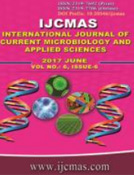


 National Academy of Agricultural Sciences (NAAS)
National Academy of Agricultural Sciences (NAAS)

|
PRINT ISSN : 2319-7692
Online ISSN : 2319-7706 Issues : 12 per year Publisher : Excellent Publishers Email : editorijcmas@gmail.com / submit@ijcmas.com Editor-in-chief: Dr.M.Prakash Index Copernicus ICV 2018: 95.39 NAAS RATING 2020: 5.38 |
Wilt and root rot diseases of chickpea caused by Fusarium oxysporum f. sp. ciceri and Macrophomina phaseolina are serious biotic constraints for chickpea (Cicer arietinum L.) production. These are most important and widespread soil- and seed-borne diseases of chickpea grown where the climate is relatively dry and warm. To find out the effective management of the diseases through seed biopriming and soil application of biocontrol agents, the field studies were conducted during Rabi season of 2013-14 and 2014-15. Seed biopriming checked the incidence of wilt and root rot in the range of 45%-60% and increased the yield of chickpea by 10%-20%. However, combined applications of seed biopriming as well as soil application significantly checked the disease incidence in the range of 46%-78% and increased the grain yield by 13%-27%. The disease control and yield enhancement were highest with T. viride followed by T. harzianum. The pooled result of two years revealed that soil application of Trichoderma viride or T. harzianum (2x108 cfu/g) enriched FYM (10 kg bioagent/ ton FYM) in furrow @ 1 ton/ ha, followed by seed biopriming at the time of sowing i.e. soaking of chickpea seeds for 10 hrs in suspension of talc based formulation 1% WP (2x108 cfu/g) of T. viride or T. harzianum, respectively @ 50 g product/ 250 ml of water/ kg seed and shade dried for the effective management of wilt and root rot complex.
 |
 |
 |
 |
 |